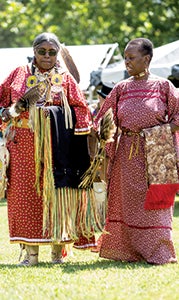Powwow ‘one of the best’
Published 10:50 am Tuesday, September 27, 2016

- Chief Earl Bass of the Nansemond Indian Tribe leads other participants into the circle during the tribe’s annual powwow in August.
Dancers in full regalia grace the sacred dance circle. Percussionists pound out the beat to which dancers stamp their feet and revolve around the circle. A kaleidoscope of color spirals in front of sets of bleachers packed with young and old taking in the cultural experience.
Before the arrival of European settlers in the Americas, a powwow for Indian tribes meant much the same to them as family reunions do today.
Except for those bleachers full of spectators, powwows haven’t changed much for those who trace their lineage to the tribes that populated this continent long before Europeans “discovered” it.
“It’s kind of like a family reunion, and not just our immediate family but more of the Indian community,” said Chief Earl Bass of the Nansemond Indian Tribe. The ancestors of the tribal association’s 300 current members lived on the banks of the Nansemond River in the early 1600s, when European settlers documented their existence. Nobody knows exactly how long before that the Nansemonds had populated the area.

Participants in the Nansemond Indian Tribe’s 2016 powwow were young and old, male and female, local and distant. There were members of the tribe from Suffolk and from as far away as New York and Wisconsin, and there were other Native American tribes represented from all around Virginia and North Carolina, especially.
One thing that has changed in a powwow is the spectators. They come by the thousands for food, vendors and educational demonstrations and displays about what life was like in Suffolk before it was called Suffolk.
But mostly, they come to watch the dancing and hear the music.
Some dancers stand erect and walk methodically, choosing each step as if it were potentially their last. Some lean forward to get closer to the earth and step their legs high before slamming their feet to the ground. Some hold tools and walking sticks; some carry live birds on their arms. Regalia reflects every color imaginable: browns and reds and whites and yellows and blues and pinks and purples.
Bass said the word about the powwow is apparently getting out.
“The powwow went great,” he said of this year’s affair, held in August. “It’s probably one of the best powwows we’ve had in a long time.”
About 5,000 people attended on Saturday alone, he estimated.
“They come out there, and they get to learn a little bit of the culture and know that we’re still there,” he added.
Nansemonds come from all around to attend the powwow, Bass said. Two families from New York and Wisconsin were special visitors this year.
Hope for the next generation is apparent at the powwow. Many members of the tribe have children, who get to meet each other and bond at each powwow.
“We had a lot of kids there,” Bass said. “We have a lot of tribal members that have kids. They got to meet each other and bond a little bit.”
Bass said the tribe appreciates the community’s support and also the partnership of the Suffolk Department of Parks and Recreation.






